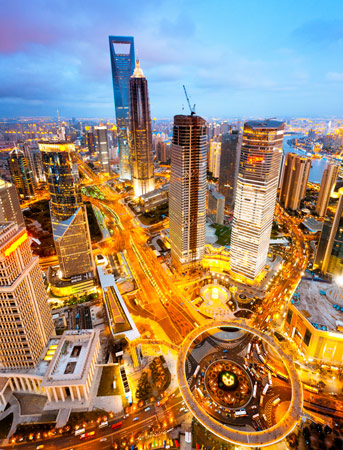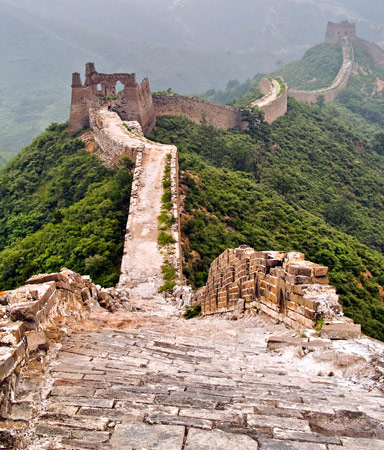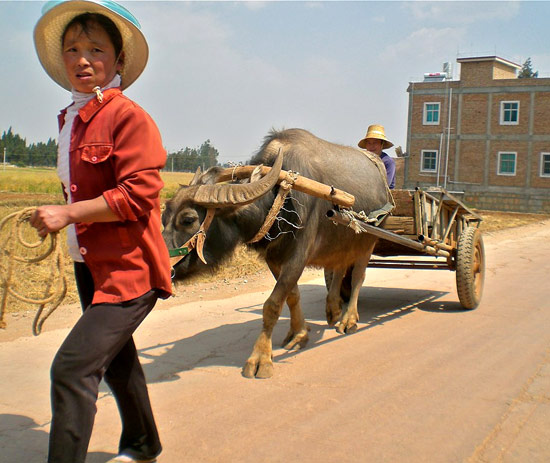Country Snapshot: Country Snapshot
Land/Geography/Regions
China is one of the largest countries in the world, accounting for more than 595,000,000 square kilometers (3,700,000 square miles) of Southeast Asia. The nation shares borders with India, Pakistan, Afghanistan, Tajikistan, Kyrgyzstan, Kazakhstan, Mongolia, Russia, North Korea, Vietnam, Laos, Myanmar, Bhutan, and Nepal. The eastern parts of China feature over 9,000 miles of coastline along the South China Sea, East China Sea, and Yellow Sea. Many Chinese islands lie in these coastal waters.
Continental China features a vast landscape with a diverse climate. The wet southeast is covered in low, rolling mountain ranges and subtropical forests. In the north lies the Gobi Desert, and in the northwest is the Taklamakan Desert. To the west, the Himalayan, Karakoram, Pamir, and Tian Shan mountains converge to form natural barriers between China and much of east and southern Asia. From the mountains, the Tibetan Plateau and its various grasslands stretch northeast across central China supporting a variety of ecosystems. The deltas of the country’s two major rivers— the Yangtze and Yellow—are found on the eastern side of the plateau.
People and Culture
The majority of the Chinese population are Han Chinese. The Han people are native to East Asia. They are the largest single ethnic group in the world. There are more than 50 other ethnic groups recognized in China including the Zhuang, Hui, Mongo, Korean, Mongol, Tibetan, and Russian. The nation also is home to immigrants from throughout Southeast Asia, Japan, and the United States.
China’s official language, and the most commonly spoken, is Standard Chinese, also known as Mandarin. Other dialects of the Chinese language include Cantonese, Taishenese, Wu, and Min. In addition to these, more than 250 other languages are spoken throughout various regions and among different communities of China. Korean is common along the nation’s border with North Korea. Turkic, Altaic, and Austronesian languages also are spoken throughout the country.
Most of the population is either non-religious or observes Chinese folk tradition, which is the traditional religion of the Han people. The Chinese government encourages atheism; however, it officially recognizes five religions: Buddhism, Taoism, Catholicism, Protestantism, and Islam. The government has less tolerance for religions outside of these five faiths.
China’s culture is based upon its ancient, traditional roots. Architectural and artistic elements throughout the country can be traced to their popularity within certain dynasties. The current culture is a mixture of a rich history and an increasingly globalized country. The nation encourages a meritocracy, and hard work is thought to be the best way to achieve a better life. The high population of China has influenced the behavior of its people. Personal space is less valued in the nation, where bumping into people is common and inoffensive. This also leads some people to be withdrawn. Developing close, warm friendships takes direct effort.
History
Archeological evidence suggests that early humans were living in what is now China over 2 million years ago. China is one of the oldest civilizations in the world, with written records going back 3,500 years. One of the first dominant civilizations to emerge from the region was the Xia Dynasty in 2100 BCE.
Since the Xia Dynasty, China has continuously expanded, fractured, and reunified. Various hereditary monarchies, called dynasties, have been responsible for the growth and consolidation of China over the last 4,000 years. In 221 CE, the Qin Dynasty began laying the framework for what China looks like today. The Qin established a Confucian ideology throughout the land and provided a common written language that deepened the country’s unification.
Imperial China has historically been one of the world’s most scientifically advanced civilizations, achieving breakthroughs like the compass, paper, gunpowder, and printing. China also produced some of the world’s great explorers. The last imperial dynasty of China was the Qing, which lasted from 1644 until 1912.
In 1912, when the Qing Dynasty officially ended, the country emerged as the Republic of China. It was led by the Kuomintang, or National Party, but the republic was politically unstable. Slowly, the Communist Party of China (CPC) began to gain traction. The country fell into a civil war, which ended in a CPC victory in 1949 when it was declared the People’s Republic of China by CPC Chairman Mao Zedong. Today the country remains under Communist control.
Climate and Biodiversity
China’s extremely diverse topography and massive land area means the country has a huge variety of climates. In the northwest, arid deserts with cold dry winters and mild summers dominate. The southwest is primarily a tundra with colder temperatures year-round and little rainfall. The center of China features an arid climate toward the north with four distinct seasons. The south features a more tropical climate with warmer temperatures year-round and increased rainfall. The east coast experiences an oceanic climate and humid subtropical climate with hot summers and cold winters. The country’s northeast corner is more continental with mild summers and dry winters.
The amazing diversity in China’s climates and ecosystems makes it home to a profound abundance of wildlife. Many species of primates can be found throughout the forests such as gibbons, apes, macaques, lorises, and langurs. The nation also is home to many species of bears, most notably the panda, red panda, and sun bear. Elephants, tigers, and wolves are common. Hundreds of species of rodents, bats, birds, reptiles, and fish can be found throughout the country. In its coastal waters there are sharks, dolphins, whales, seals, and countless species of coral fish, rays, invertebrates, and sea plants.
Economy
The renminbi is the official currency of China, but it is often referred to as the yuan. Some of China’s biggest exports are agricultural commodities including cotton, tea, rice, soybeans, and potatoes. Manufactured goods also are a significant part of the nation’s exports and include electronics, machinery, furniture, clothing, textiles, medical equipment, plastics, iron and steel, footwear, concrete, and chemical fertilizers.
China has the world’s largest telecommunications market, with the most cell phone and internet users in the world. The country has rapidly developed their infrastructure, and construction and transportation have played a major role in growing the nation's economy. Tourism also serves as a significant economic driver, as China is one of the most visited countries in the world. Chinese nationals also travel domestically frequently.
Government
China’s capital city is Beijing. The nation has 33 provincial-level districts, all of which have some amount of political autonomy. At the national level, China is a one-party socialist republic led by the Communist Party of China. A president serves as the head of state and chairman of the Central Military Commission. The president is the country’s paramount leader, possessing the most power in the government. A premier serves as the head of government.
At the state level, the National People’s Congress has the most legislative power. It is made up of 2,980 members who are responsible for electing a State Council, Central Military Commission, National Supervisory Commission, Supreme People’s Court, president, and premier.
The judicial system of China is meant to act independently of the influence of all levels of government, people, or institutions. The Supreme People’s Court of China is the highest court in the land. At the local level are local people’s courts that oversee the majority of cases. There also are Courts of Special Jurisdiction including internet courts, military courts, maritime courts, and intellectual property courts. As Hong Kong and Macau are special administrative regions, they have been allowed to maintain their own, independent court systems.
Article written for World Trade Press by Taylor Holloran.
Copyright © 1993—2025 World Trade Press. All rights reserved.

 China
China 


